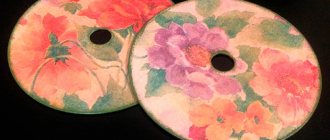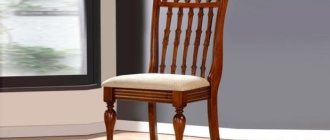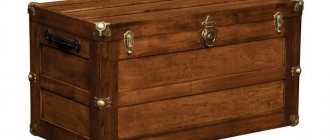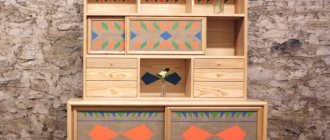How to make a wooden hanger with your own hands? It's very simple, we'll tell you how. It would seem, what is a hanger in the house? Almost no one notices it, even though it is quite a significant and functional item. You will be surprised how you can improve it, and even do it yourself. There are no special skills required, so anyone can do it.
From pebbles
Not only perfume caps, but also other memorabilia can be put on hangers. For example, sea pebbles, which we usually bring from the sea and then don’t know where to put, will look very stylish on the wall. Unfortunately, we did not find a master class or at least the author of this idea, but we can advise how to make such a hanger. Take a couple of screws and metal cylinders (they should be a little wider or a little shorter). Insert screws into the cylinders and screw into the base boards. Apply universal glue to the screw heads and glue the stones to them.
DIY floor wooden hanger
Wooden things have always been of high quality and durable, as well as useful in everyday life. This also applies to hangers, so we will now try to build a wooden floor hanger with our own hands. This work will not take us much time. You will need approximately 20 free minutes, as well as all the necessary materials.
To create a wooden floor hanger we will need:
- Six tribes (copper).
- Four tees (copper).
- Four plugs (must be the same inlet diameter).
- A wooden round stick of the same diameter. The total length should be 5.3 meters, cut into parts: 2 pieces of 125 cm, two more of 70 cm, 4 pieces of 20 cm, and the last 6 of 10 centimeters each.
The process is very simple. Following the drawing plan, we must assemble all the structural elements. To make the task easier, they are marked with letters in the figure.
- "A" - 125cm.
- "B" - 70cm.
- "C" - 20cm.
- "D" - 10 cm.
To further secure our floor hanger, use wood glue. Copper inserts will look interesting; on the one hand, they will attract attention, and on the other, they will be quite durable in use.
Related article: Installing a convector with your own hands
From tassels
The idea to make hooks from brushes came to designer Dominic Wilcox when he remembered leaving painting tools in paint after work, only to find them frozen and unusable the next day. Well, brushes with curved bristles can still serve in the household. To make these, you'll need curing paint or some reliable glue.
Extraordinary ideas for a wooden hanger
Floor and wall hangers are considered classics, but when you want something unusual or creative, you can consider the following design options.
- A collection of things that is similar to an exhibition from the world famous TV series with Carrie Bradshaw. The idea is that when you get into the corridor, you don’t spend a long time rummaging about which hat or scarf to wear today, but simply choose from the things hanging out.
In order to turn your idea into reality, you will need a free wall in the corridor and ordinary hooks. This will become not only a kind of interior design for the corridor, but also an extraordinary approach to solving the issue of hangers.
- With the help of different types of hooks, you can emphasize a particular interior style, be it classic or modern.
- Believe it or not, the most seemingly inappropriate items can be hangers. A very unusual approach would be to use old pitchforks or rakes in this matter, playing with them to suit the desired theme. You just need to cover the sharp ends with it first, so that neither you nor your guests get hurt.
- Fans of hiking and traveling can use old skis or oars as hangers.
- Old chess pieces will serve as an original substitute for ordinary hooks.
- In a vintage style, you can use old doors to create a coat rack, perhaps even with nails instead of hooks. Of course, you will first need to treat the surface, but imagine the idea itself already in execution. Quite shocking, especially if you work on the small details.
In this idea, you can also use an old fence instead of doors.
- The motif of a tree on which hooks for things are located has become popular today. It can be cut out of a piece of wood, or simply painted on the wall, placing hooks on the branches.
Tools for work
Since the structures are attached to the wall and are made of different building materials, it is impossible to do without special devices and tools.
For work you may need:
- Hammer;
- Screwdriver;
- Saw or hacksaw for wood;
- Jigsaw with attachments for metal and wood;
- Hammer;
- Self-tapping screws, screws, dowels;
- Pencil and tape measure for marking;
- Building level;
- Paint for wood and metal;
- Brushes;
- Sandpaper (grit No. 60) or grinder attachment.
Before work, it is necessary to prepare the material: clean the dirt and sand the wood, wash the metal from contamination, paint the frame made of boards or punched sheets, etc. And also clear the place chosen for the hanger in the hallway.
Cutting and sanding
After obtaining the outline on the workpiece, you can begin to cut it out using a small jigsaw or saw
You need to work carefully so as not to crumble or damage the edges of the hanger. The resulting semi-finished product will have a rough surface that needs to be sanded after moistening, directing hand movements along the wood fibers
The length of the hanger varies at the discretion of the craftsman; you can make a long structure with a shoe stand located almost at the floor. In small rooms, a shortened hanger is organic, under which there is a bedside table, shelves or ottoman.
Rounding can be achieved by processing with fine-grained sandpaper. Experienced craftsmen do not recommend using special wire sold in stores for grinding; it is intended for other materials.
A well-prepared wood surface, when stroked with a hand on which a nylon stocking is placed, will not leave any snags and will create only pleasant sensations. If you feel any of these, it means the job was done correctly and the wood can be varnished.
External design of hooks
Even such an insignificant item as a hanger with hooks can beneficially complement the overall style of the interior, so if you wish, you can choose products of various shapes and colors according to your personal preferences.
Table No. 4. Choosing hooks according to the interior features
| Style, illustration | Description |
| Art Deco | This style is characterized by the presence of shiny surfaces with various metallic elements. Therefore, it is recommended to choose hooks made of bronze or brass. |
| Loft | Loft is a style that includes various industrial elements. Therefore, hooks in the form of various nails and pipes are suitable here. In this case, you can be smart and make products from any available materials. |
| High tech | This style includes the presence of laconic interior elements. Therefore, in this case, you can choose the simplest products possible, in solid colors. |
| Minimalism | Minimalism presupposes the simplest furnishings in the room, devoid of various decorative delights. That’s why hooks are chosen in simple shapes and discreet colors. |
Steps
- Choose your hook material.
You can use wooden or plastic chopsticks or a hardwood dowel. You can even try using a flat, well-dried twig. The work will be less labor-intensive if the material initially has a size and shape close to the hook, especially in diameter.
- If you decide to use a chopstick, take a high-quality, long one made from bamboo. The cheap, brittle chopsticks you get when you order Chinese takeout won't be able to be sanded smooth.
- Different materials require different handling. For example, wooden and plastic hooks will turn out completely different from factory metal ones. Try different ones to see which hook suits you best.
- For a list of the rest of the items you'll need, see the "What You'll Need" section below.
- Decide on the length of the hook.
You can make the length similar to the finished hook, which is convenient for you to work with. If in doubt, the optimal length would be 15 cm. You can also choose the length depending on the product you intend to knit. So, for Tunisian knitting or a very large product, you need a long hook.
Decide which side the hook itself will be placed on if the material you are cutting from is not cylindrical (for example, rectangular chopsticks or a raw twig).
Which side is flatter? Which side is wider? If you are working with a chopstick, you can take into account the patterns and decor applied to it.
Cut to desired length or slightly longer.
Remember that during carving, part of the material will be sawed off, and it’s easy to remove the excess length after finishing the work, but lengthening it will be problematic. If you wish, you can leave this step for last so that you know the exact length of the hook.
Make a large mark at the end where the hook will be located.
The easiest way to do this is by sticking the tip of a stick or dowel into a pencil sharpener. Or you can simply round the corners with a knife.
Cut out the neck of the hook.
It doesn't have to be perfectly round, but you can round off the square edges of the stick. If you need a smaller hook, you can plane the narrow end of the stick or grind the diameter of the dowel on the hook side and leave the other end thick for strength.
- Make the neck as smooth, even and symmetrical as possible. Plane with long, continuous strokes in the direction of the grain of the wood and rotate the material as you go.
- The neck length must be at least 3.5. The specific length is not important.
- If you rounded the tip with a sharpener, use its shape as a guide when rounding the neck.
If you are rounding the tip of a chopstick, plan more on the short sides and only a little on the long sides.
This is not the last sanding, so don't overdo it. Simply remove noticeable bumps and chips.
At this stage, use coarse sandpaper to round the tip.
This will make it easier to figure out where to cut for the hook.
Make a bracket mark where the first hook cut will be.
Or you can simply imagine this mark. Make it a little further from the tip than necessary. You will cut out the hook much later. The location and shape of the hook can be copied from a store hook or its photo.
Make a cut at a 45 degree angle on the mark to approximately half the thickness of the stick.
This will be the beginning of the hook. The photo shows a saw made from a multifunctional folding knife, but you can use any other saw or plan with a knife.
Deepen and widen the cut by whittling with a knife.
Be careful not to cut all the way through. At its narrowest point, the width of the neck should be between a third and half of its original thickness.
Raise the corners of the cut.
This is not necessary, but it will make it easier to grip the thread. Note that this will make the neck even thinner, so don't overdo it, especially if the hook is already thin.
Shape the head and shorten it as needed.
If the tip is too long, it will be difficult to insert into the loops. If you used a sharpener, you can sharpen it again. If not, just keep planing and sanding until you get a round head. Rotate the hook throughout the process to create a smooth, round finish, especially when sanding.
- The shape and size of the hook tip depends on your personal preference. Try a few different shapes or keep changing shapes until you feel comfortable.
Whenever possible, sand in the direction of the grain of the wood. An inexpensive flat file will help you reach the inside of the hook bend. Remember that sanding can also be used to achieve the final shape.
You will quickly discover areas that need to be sanded again. Give yourself time to get used to a wooden hook if you have used metal ones before. Give the hook time to develop. Over time, it will become softer, absorb sebum and glide easier without clinging to the yarn.
- Practice and experiment. A pair of chopsticks and most wooden dowels are long enough for several hooks, so there is room for experimentation. Having mastered the subtleties, you can do a lot intuitively or by eye. You may be better able to make hooks that suit your crocheting style and specific goals.
Most likely, you will not exactly reproduce the dimensions of a store hook. The size is mainly affected by the diameter. Measure the neck diameter and compare it to the pre-made hook size chart to see what size your hook is closest to. Most stitches can be adapted to fit almost any hook size and thread thickness. You might want to know a little more about this if size is a factor in your knitting.
Step-by-step assembly instructions
An ordinary piece of furniture, such as a coat rack, can be turned into a functional piece of art. This can be a vertical or horizontal structure made of any type of pipe. The assembly of structures from various materials has its own characteristics.
Metal pipe hanger:
- Creating the foundation. We connect 2 pipes of 60 cm each horizontally through a tee. We do the same with the remaining pair of pipes of this length;
- Top bar. Glue two corners to the ends of the 90 cm pipe;
- We place one end of each 150 cm pipe in the base tee, cover the second with the corner of the top strip;
- We close the ends of the base pipes with plugs.
PVC pipe hanger:
- Let's make a stand. We connect 6 12 cm pipes with tees horizontally. This resulted in three separate elements. We thread one of the blanks into the tees of the others. We form the legs from the corners;
- Hands hangers. We assemble the parts - tee, 15 cm pipe, corner;
- Rack. We insert an 80 cm pipe into the central tee of the stand, then an arm, a 20 cm pipe, another arm and again a pipe. Cover the top with a cap. The arms of the hanger should be directed in different directions, and the corners should be raised up.
Warnings
- To protect your thumbs, wear a soft thimble while planing. It can be quickly sewn by hand from thick fabric such as rags. It is the same as a regular thimble, but is sized to fit your thumb.
- Never point the knife at yourself or anyone else when working, so it won't hit anyone if it slips. If it's more convenient, work on a hard surface like a workbench. You can protect the surface with oilcloth for cutting, an old magazine or a piece of cardboard.
Photo of wooden hangers in the interior
As you can see, you can make a wooden wall or floor hanger - for clothes or jewelry, for children and adults, for a dressing room or for a hallway. This could be either a classic or some unusual hanger made of wood - from skis, hammers, old things, a fence or doors, from pallets and so on. The main thing is to use your imagination, and for inspiration I suggest looking at photos of various wooden hangers that you can make with your own hands.
We can conclude that there are quite a lot of options for hangers, as well as ideas for their implementation, and each of them is unique in its own way. Therefore, choose which of the ideas will best suit your home and start making your own masterpiece. Drawings and available materials will help you with this. The main thing is to have an original idea and the mood to implement it.
Related article: How to plaster slopes correctly











